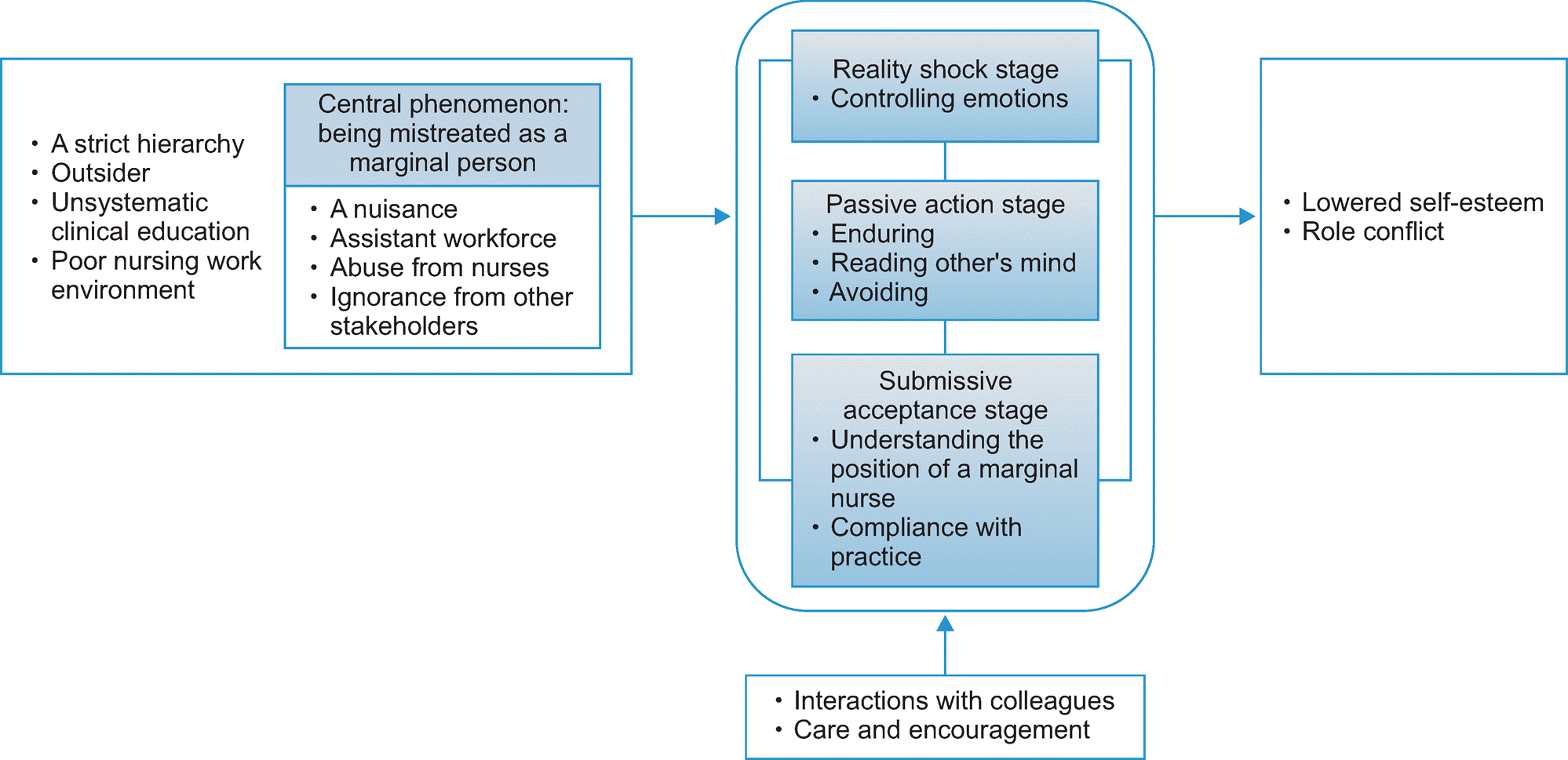Abstract
Purpose
This qualitative study aimed to explore the experience of incivility among nursing students.
Methods
Sixteen nursing students who had experienced incivility during their clinical placement were invited for one-on-one interviews until the point of theoretical saturation. The grounded theory approach of Corbin and Strauss was adopted to analyze transcribed interview contents.
Results
Incivility occurred in the context of a hierarchical organizational culture, due to nursing students’ position as outsiders, non-systematic clinical education, and poor nursing work environment. The experience of incivility was identified as “being mistreated as a marginal person,” and nursing students responded to this phenomenon in the following three steps: reality shock, passive action, and submissive acceptance. This process caused students to lose self-esteem and undergo role conflict. Furthermore, nursing students’ experience of incivility could eventually lead to workplace bullying in nurses.
Conclusion
The results of this study suggest that nursing students’ experience of incivility can be a process that threatens their identity. It is necessary to develop educational programs and provide appropriate counseling services so that nursing students can actively cope with the incivility. In addition, institutional plans are needed to ensure safe and supportive clinical learning environments.
References
1. Korea Nurses Association. Resources; statistics of educational institution [Internet]. Seoul: Author;c2017. [cited 2017 Oct 20]. Available from:. http://www.koreanurse.or.kr/resources/statistics.php.
2. Vallant S, Neville S. The relationship between student nurse and nurse clinician: Impact on student learning. Nursing Praxis in New Zealand. 2006; 22(3):23–33.
3. Wallace L, Bourke MP, Tormoehlen LJ, Poe-Greskamp MV. Perceptions of clinical stress in Baccalaureate nursing students. International Journal of Nursing Education Scholarship. 2015; 12(1):https://doi.org/10.1515/ijnes-2014-0056.

4. Anthony M, Yastik J, MacDonald DA, Marshall KA. Development and validation of a tool to measure incivility in clinical nursing education. Journal of Professional Nursing. 2014; 30(1):48–55. https://doi.org/10.1016/j.profnurs.2012.12.011.

5. Babenko-Mould Y, Laschinger HK. Effects of incivility in clinical practice settings on nursing student burnout. International Journal of Nursing Education Scholarship. 2014; 11(1):145–154. https://doi.org/10.1515/ijnes-2014-0023.

6. Clarke CM, Kane DJ, Rajacich DL, Lafreniere KD. Bullying in undergraduate clinical nursing education. Journal of Nursing Education. 2012; 51(5):269–276. https://doi.org/10.3928/01484834-20120409-01.

7. Rad M, Ildarabadi EH, Moharreri F, Karimi Moonaghi H. Causes of incivility in Iranian nursing students: A qualitative study. International Journal of Community Based Nursing and Midwifery. 2016; 4(1):47–56.
8. National Institute of Korean Language. The Korean standard dictionary [Internet]. Seoul: Author;c2017. [cited 2017 Oct 18]. Available from:. http://stdweb2.korean.go.kr/main.jsp.
9. Anthony M, Yastik J. Nursing students’experiences with incivility in clinical education. Journal of Nursing Education. 2011; 50(3):140–144. https://doi.org/10.3928/01484834-20110131-04.
10. Tecza BM, Boots BK, Clay PM, Kirkman KS, Mains BC, Newton EE, et al. Development of an instrument to measure civil and uncivil behaviors in the hospital clinical environment: Implications for nurse leaders. Journal of Nursing Administration. 2015; 45(7-8):391–397. https://doi.org/10.1097/NNA.0000000000000220.
11. Hunt C, Marini ZA. Incivility in the practice environment: A perspective from clinical nursing teachers. Nurse Education in Practice. 2012; 12(6):366–370. https://doi.org/10.1016/j.nepr.2012.05.001.

12. Longo J. Horizontal violence among nursing students. Archives of Psychiatric Nursing. 2007; 21(3):177–178. https://doi.org/10.1016/j.apnu.2007.02.005.

13. Einarsen S, Hoel H, Notelaers G. Measuring exposure to bul- lying and harassment at work: Validity, factor structure and psychometric properties of the Negative Acts Questionnaire-Revised. Work and Stress. 2009; 23(1):24–44. https://doi.org/10.1080/02678370902815673.
14. Felblinger DM. Incivility and bullying in the workplace and nurses’ shame responses. Journal of Obstetric, Gynecologic, & Neonatal Nursing. 2008; 37(2):234–242. https://doi.org/10.1111/j.1552-6909.2008.00227.x.

15. Celik SS, Bayraktar N. A study of nursing student abuse in Turkey. Journal of Nursing Education. 2004; 43(7):330–336.

16. Lasiter S, Marchiondo L, Marchiondo K. Student narratives of faculty incivility. Nursing Outlook. 2012; 60(3):121–126. https://doi.org/10.1016/j.outlook.2011.06.001.

17. Thomas J, Jinks A, Jack B. Finessing incivility: The professional socialisation experiences of student nurses’ first clinical placement, a grounded theory. Nurse Education Today. 2015; 35(12):e4–e9. https://doi.org/10.1016/j.nedt.2015.08.022.

18. Ibrahim SA, Qalawa SA. Factors affecting nursing students’ incivility: As perceived by students and faculty staff. Nurse Education Today. 2016; 36:118–123. https://doi.org/10.1016/j.nedt.2015.08.014.

19. Rad M, Karimi Moonaghi H. Strategies for managing nursing students’ incivility as experienced by nursing educators: A qualitative study. Journal of Caring Sciences. 2016; 5(1):23–32. https://doi.org/10.15171/jcs.2016.003.

20. Hyun MS, De Gagne JC, Park J, Kang HS. Incivility experiences of nursing students in South Korea. Nursing Ethics. Forthcoming. 2016; Dec 21.https://doi.org/10.1177/0969733016684546.

21. Jo SO, Oh JA. Validity and reliability of the Korean version of a tool to measure uncivil behavior in clinical nursing education. Journal of Korean Academic Society of Nursing Education. 2016; 22(4):537–548. https://doi.org/10.5977/jkasne.2016.22.4.537.

22. Corbin J, Strauss A. Basics of qualitative research: Techniques and procedures for developing grounded theory. 4th ed. Thousand Oaks (CA): Sage;2015. p. 1–310.
23. Guba EG, Lincoln YS. Effective evaluation: Improving the usefulness of evaluation results through responsive and naturalistic approaches. San Francisco (CA): Jossey-Bass Publishers;1981. p. 103–127.
24. Thomas SP, Burk R. Junior nursing students’ experiences of vertical violence during clinical rotations. Nursing Outlook. 2009; 57(4):226–231. https://doi.org/10.1016/j.outlook.2008.08.004.

25. Randle J. Bullying in the nursing profession. Journal of Advanced Nursing. 2003; 43(4):395–401. https://doi.org/10.1046/j.1365-2648.2003.02728.x.

26. Kang J, Yun S. A grounded theory approach on nurses’experi-ence with workplace bullying. Journal of Korean Academy of Nursing. 2016; 46(2):226–237. https://doi.org/10.4040/jkan.2016.46.2.226.
27. Luparell S. Incivility in nursing: The connection between academia and clinical settings. Critical Care Nurse. 2011; 31(2):92–95. https://doi.org/10.4037/ccn2011171.

28. Curtis J, Bowen I, Reid A. You have no credibility: Nursing students’ experiences of horizontal violence. Nurse Education in Practice. 2007; 7(3):156–163. https://doi.org/10.1016/j.nepr.2006.06.002.

29. International Council of Nurses. Fact sheet: Violence: A world-wide epidemic [Internet]. Geneva: International Council of Nurses;c2009. [cited 2017 Jul 10]. Available from:. http://www.icn.ch/images/stories/documents/publications/fact_sheets/19k_FS-Violence.pdf.
Table 1.
Relationships among Categories in the Paradigm Model




 PDF
PDF ePub
ePub Citation
Citation Print
Print



 XML Download
XML Download